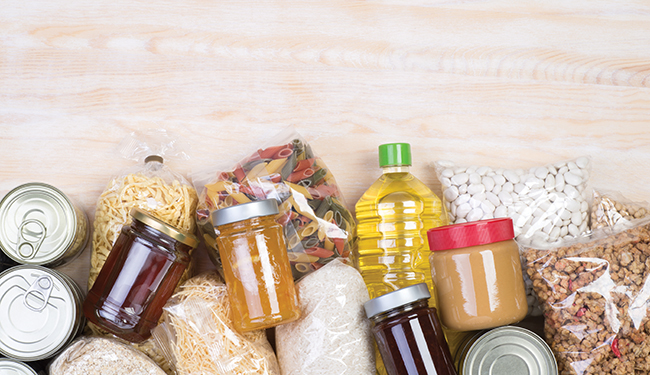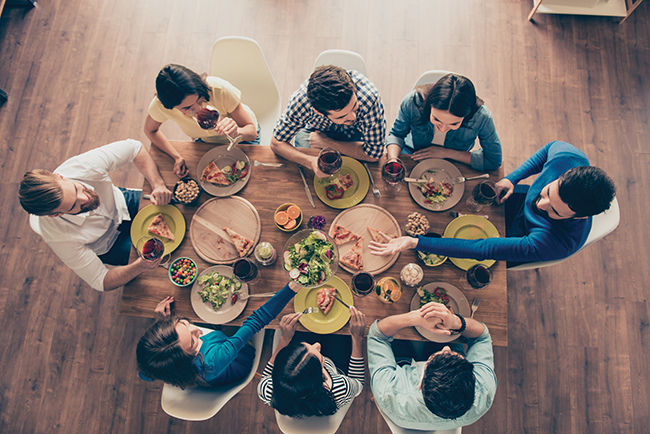Going gluten-free can be a difficult transition to make. Charlotte Willis provides her 10-step guide to make the change flawless…

After months of discomfort, digestive difficulties, and wrestling with your diet, you find yourself here. Perhaps it’s taken you a while to come to this conclusion: gluten and your gut, well they just don’t seem to be on the same page. Maybe you’ve been medically diagnosed as gluten-aversive, suddenly thrusting yourself unknowingly into the world of free-from products and complicated eating habits. Becoming gluten-free usually entails a complete overhaul of your diet, something which is definitely not to be snuffed at as a faddy diet, or the subject of ridicule for following a trendy way of eating. Everything from eating out to eating on the go, meals that you make for, and share with, your family, and those gut-trembling moments of accidental consumption, a gluten-free lifestyle demands trials and tribulations.
How Times Change
But before you condemn yourself to a diet of rice and rubbery bread, you’ll be pleased to hear that being gluten-free in the 21st century has never been so easy. Honestly. Put it down to the rise in demand for gluten-free products, coupled with the huge increase in people identifying as gluten-intolerant. Food manufacturers rush to their product development labs, eager to create the latest and greatest free-from product ranges to slide right into this ever expanding market.
I remember the days when the free-from aisles we know and love today were confined to a small, sparse granola-bar-clad shelf next to the baking goods. Nothing like the wide, high and vast sections we find in all major supermarkets in 2018. This being said, the reality of becoming gluten-free is often quite an overwhelming experience. There is a lot to consider, but following my 10 simple tips to get you started will ensure success and a transition into your new diet with ease.
Be Prepared To Shop Around
As a gluten-free vegan, shopping at one supermarket, I’m afraid, is not really a sustainable option for me! The same can be said of following any free-from lifestyle. While I love the idea of getting all my weekly shop from Ocado, shopping not only enables me to discover a variety of different and exciting new products that I can eat, found lurking in the free-from aisles of about 4 different supermarkets, I also end up saving a lot of money.
I have unearthed a delicious sugar-free soya yoghurt at Tesco, the best GF bread range found on Ocado, some organic grain-free tortilla chips at Waitrose, and a delightful free-from chocolate tiffin I stockpile from Sainsbury’s. And no, I don’t dedicate a day to travelling all around these supermarkets, I simply pick some up whenever I’m passing by or have some spare time. By visiting stores and shopping around, you’ll be more likely to discover some hidden gems that’ll soon become your favourite foods.
Get Information
Treat becoming gluten-free as you would treat searching for the best new upgrade of phone to buy, or area in which to buy your first home: do some quality hours of preparatory research and avoid yourself a few years of disappointment, confusion and headache. When making a change to my diet or lifestyle, I always look to others who have done so before me. Their footsteps I can wilfully follow with trust, guiding me through a perplexing, unknown world.

Bloggers, Instagrammers, authors, GF websites and Pinterest pinners: all great sources of information, inspiration and innovation. The more time you spend reading and scrolling, the better educated and aware you’ll become, helping you avoid pitfalls and master your new lifestyle with ease.
Re-Discover Grains
If, like me, the notion of living a carb-free lifestyle makes you want to bury your head in the nearest tiger loaf, well I have good news. Gluten, as I’m sure you are aware, is a storage molecule of energy for the plants that surround us. But not all of the staple grains that constitute our diets contain gluten. There are a multitude of naturally-GF grains including: millet, rice (all varieties), quinoa, buckwheat, cornmeal, polenta, amaranth, sorghum and teff.
Oats are normally safe to eat as part of a gluten-free diet, but use caution as some are contaminated with gluten during milling processes (if hyper-sensitive, opt for certified GF oats). And what’s more, there is a bevy of gluten-extracted wheat products out there that can satisfy your lust for bread and the desire for dough, so there’s no need to go paleo on me just yet.
Gluten-Free Your Favourites
Ah, what’s more satisfying than a biscuit dunked in a cup of tea at the end of a long day? Or perhaps you enjoy a good old fashioned sandwich at lunchtime, or home-baked cake on the weekend. Becoming GF doesn’t mean you have to omit these from your diets, unless you choose to do so. No, luckily for us, there is a whole community of GF bloggers ready to provide your perfect recipe for a fluffy Victoria sponge and the best GF bread recipe or brand to buy.

Check out your nearest free-from aisle to uncover a delicious range of GF products from biscuits to flapjacks. This is particularly important when you are beginning to transition and change your diet in weeks 1-2, habitually reaching for a bourbon or custard cream out of your old desk draw, only to leave yourself devastated at the realisation you are unable to satisfy your cravings!
Tell Everyone. Be Confident
One of the most intimidating aspects of changes in lifestyle, be they dietary or otherwise, is undoubtedly the sharing and public announcement that follows your final decision being reached. It’s bad enough attempting to organise yourself, let alone answering 101 probing and personal questions, some of which you may not know the answers to just yet.
For some of us, telling friends and family of your gluten-free lifestyle will be but a ripple in the ocean. For others, a tidal wave in a paddling pool. If you are left feeling intimidated, my best advice is to be confident and get behind your decision wholeheartedly before you decide to share your news. Get your facts ready and the thickest layer of skin you can muster!
Eat Out With Ease
Mates invited you out to a bar? Sunday lunch beckoning? Or perhaps you’ve forgotten about your sister’s birthday dinner next Tuesday? Ah the age-old conundrum of what can I eat? I know it all too well. In fact I am synonymous amongst my non-vegan friends for rummaging through their kitchen cupboards, burrowing through the fridge and raiding the nearest supermarket upon overnight stays to ensure I am well-armed for the upcoming ventures in (my favourite game) what-can-I-eat-in-this-house?

Eating out on a GF diet is simple these days, with the vast majority of chain restaurants being one step ahead of the game. Think GF pizza dough, GF burger buns and GF options clearly labelled. A simple glance over the menu online will help you identify your options before you go. If you think (or know) you’ll be heading to an eatery with limited choice, why not call ahead? These days, GF is so common, almost everywhere will be able to come up with a delicious solution with ease!
Familiarise Your Family
Call me cynical, but telling your family about a recent dietary change is all too often met with an anxious look from Mum, despairing look from Dad and a judgemental conversational tone that is sure to slide them directly toward the bottom of your GF dinner party list. When it comes to dining with your family for the first few occasions as a GF individual, why not offer to bring your own alternative options (such as a GF gravy to a Sunday roast or a home-baked GF cake to a birthday party).
Or if you’re feeling particularly brave, beat them to it by hosting your own GF evening, lunch or party for your next get-together. You can showcase your new dietary choice in full-on gloat mode, and prepare yourself for any questions that may follow. *eye rolling guaranteed*

Get Baked
I bet you thought that going GF would mean ditching the baked goods, the freshly made bread and afternoon teas for good right? Well, first of all, you should know that GF baking isn’t as complicated as you may have first thought. Crafting your own free-from bakes is as simple as using a GF flour and following one of thousands of fantastic GF recipes that can be found in this very magazine and online by GF baking bloggers and foodies alike.
My best advice would be to follow a certified GF recipe, as making a traditional bake GF by substituting is not always going to produce the best results. But, there really isn’t anything that you’ll be missing out on. Breads, cakes and all sorts of bakes are available to purchase at most supermarkets these days, and there are an assortment of wonderful recipe guides and books to thumb through on a Saturday afternoon by the Aga (or a Monday night by your shared oven… let’s be honest).
Don’t Be Afraid To Make Errors. Just Be Prepared.
Trial and error is a huge part of any shift in dietary patterns. There will be times when you mistakenly devour a wheat-based cracker from a bread basket and forgo your gluten-omitting ways by human error. The solution is to arm yourself with the necessary knowledge and recovery kit to help your body digest to the best of its abilities.
Ease the cramps in your stomach by drinking peppermint and ginger teas, increase the amount of fibre in your diet for the next few days to flush through the gluten, and take some digestive enzymes and probiotics to help boost your gut flora. Don’t place added stress and anxiety on the body by worrying needlessly, simply learn from your error and move on.
Get Social
Finding it hard to get advice from your immediate group of friends? Try going online and getting social with other gluten-free individuals by searching on Facebook for groups in your area. It’s a simple way to start talking to a community of individuals, with whom you can discuss your diet and divulge any anxieties or hang-ups you may have.
These groups often offer insider secrets, shopping tips and recipe advice to help improve and expand your free-from repertoire. After all, a problem shared…
About the author
 Charlotte Willis is a student researcher of nutrition and human disease. Studying to become a Doctor of Human Nutrition, she is particularly interested in wholefood, plant-based nutrition and healthful lifestyle intervention in the prevention and reversal of chronic human diseases.
Charlotte Willis is a student researcher of nutrition and human disease. Studying to become a Doctor of Human Nutrition, she is particularly interested in wholefood, plant-based nutrition and healthful lifestyle intervention in the prevention and reversal of chronic human diseases.
